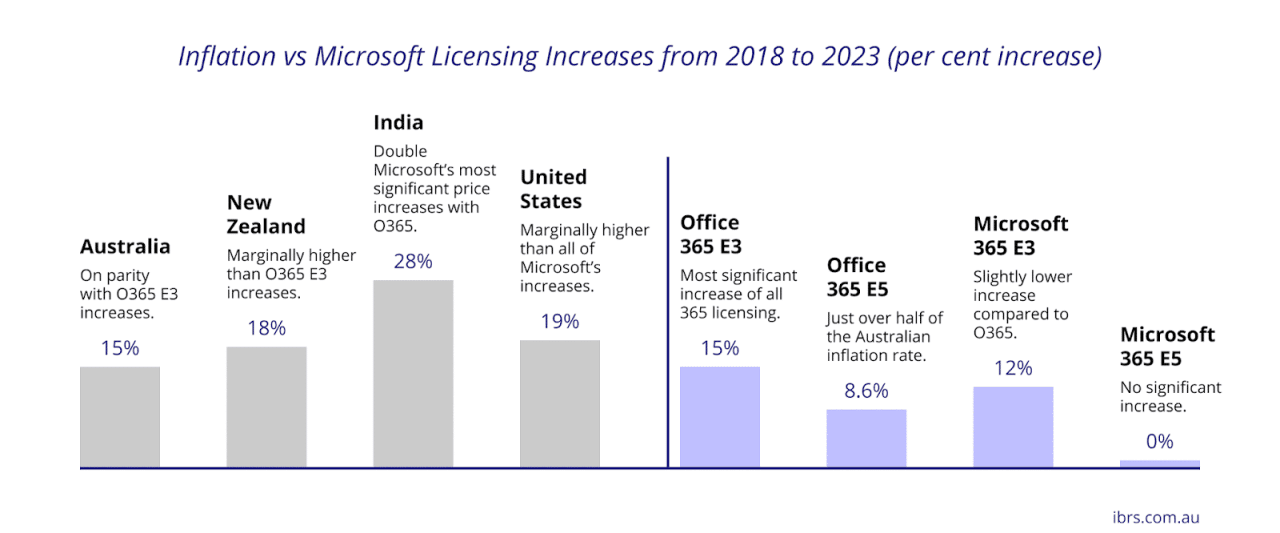Observations
Table 1: Key Pricing and Structural Changes
- Volume Discounts: As of November 2025, all customers start at the same list price (Level A) regardless of organisation size.
- Teams Unbundling: Teams is now a separate add-on for all Office 365 enterprise plans. This allows organisations to avoid paying for Teams if they use alternative collaboration tools, but incurs an additional cost of AUD7.90 if Teams is required.
- Annual vs Monthly Billing: Annual commitment is standard. Monthly billing is available but incurs a 5 per cent premium.
- On-Premises Price Increases: On-premises license prices increased of 10per cent for Exchange, SharePoint, or Skype for Business, and came into effect in July 2025.
- CAL Suite Increases: Core CAL Suite up 15 per cent, Enterprise CAL Suite up 20 per cent as of August 2025.
The End of Volume-Based Discounting
The most financially impactful change is the elimination of programmatic, tiered pricing for online services within the Enterprise Agreement, MPSA, and OSPA, effective for renewals from 1 November 2025. All customers will now default to the standard Level A list price, removing the automatic discounts previously afforded to larger organisations. The direct impact is a non-negotiable price increase for those who benefited from price levels B, C, and D.
Table 1: Estimated Price Increase by Former EA Level
| Former Price Level | Typical User Count | Estimated Price Increase on Online Services |
| Level A | 300 – 2,399 | 0% (no discount) |
| Level B | 2,400 – 5,999 | ~6% |
| Level C | 6,000 – 14,999 | ~9% |
| Level D | 15,000+ | ~12% |
Secondary Increase Implications
Microsoft has removed Premier Support options for its enterprise clients and replaced that ‘pay for what you need’ model with a Unified Support model based on an organisation’s total contracted value with Microsoft. Therefore, any increases in licensing – including those resulting from these announcements- will increase Microsoft Universal Support fees as well.
Benchmark Price Hike
To gauge the financial impact of the removal of discounting, consider a large organisation with 15,000 users on Microsoft 365 E5, previously qualifying for a Level D discount of approximately 12 per cent. At the Australian list price of AUD81.90 per user per month, (currently discounted by 12 per cent to $72.07), the removal of this discount translates to an annual cost increase of around AUD1,769,400, plus a secondary increase for Unified Support of around AUD80,000.
Calculation
Monthly Discount Lost * Months * Employees = Annual Licensing Increase
$9.83 * 12 * 15,000 = AUD1,769,400 annual increase
Unified Support Increase (assuming 4.5%) = $79,623 annual increase
Total annual increase: AUD1,849,023
Understanding Microsoft’s Commercial Strategy
Microsoft has announced a series of interconnected pricing and program changes that will materially alter the commercial landscape for its largest customers. Microsoft claims these adjustments are a strategy to standardise pricing and accelerate the transition to modern cloud agreements.
However, a deeper analysis of Microsoft’s financial performance suggests this is more a response to its aggressive investments in global cloud infrastructure and, in recent years, AI. Based on financial filings, the ratio of Microsoft’s investment in new infrastructure as a percentage of revenue has climbed from 6.30 per cent in 2015, to 18.61 per cent in 2024. In April 2025, Microsoft announced it was significantly reducing or halting cloud infrastructure investments in some regions, and in May 2025, it reduced its workforce by 9,000 people.
Table 2: Microsoft’s Revenue and Capital Investments
| Year (Fiscal Year Ending June 30th) | Capital Investments (USD in Billions) | Revenue (USD in Billions) | Year-over-Year Revenue Growth (%) | Number of Employees (End of Fiscal Year) | Year-over-Year Staff Growth (%) (Absolute Change) | Staff / Revenue Ratio | Capital Investments / Revenue |
| 2015 | 5.9 | 93.6 | 8% | 118,000 | N/A | $793,220 | 6.30% |
| 2016 | 8.3 | 85.3 | -9% | 114,000 | -3.40% | $748,246 | 9.73% |
| 2017 | 8.1 | 89.95 | 5% | 124,000 | 8.80% | $725,403 | 9.01% |
| 2018 | 11.6 | 110.4 | 14% | 131,000 | 5.60% | $842,748 | 10.51% |
| 2019 | 13.9 | 125.8 | 14% | 144,000 | 9.90% | $873,611 | 11.05% |
| 2020 | 15.4 | 143 | 14% | 163,000 | 13.20% | $877,301 | 10.77% |
| 2021 | 20.6 | 168.1 | 18% | 181,000 | 11.00% | $928,729 | 12.25% |
| 2022 | 23.9 | 198.3 | 18% | 221,000 | 22.10% | $897,285 | 12.05% |
| 2023 | 28.1 | 211.9 | 7% | 221,000 | 0% | $958,824 | 13.26% |
| 2024 | 44.5 | 245.1 | 16% | 228,000 | 3.20% | $1,075,000 | 18.16% |
The New Commercial Reality: Margin Recovery and AI Investment
These changes are indicative of a deliberate strategy by Microsoft to improve margins after a decade of relatively stable EA pricing. Having successfully migrated the majority of the market to subscription services and entrenched its premium E5 suite, the vendor is now capitalising on its market position.
In addition, Microsoft has been leveraging its ‘bundle then divide’ strategy for the last five years, successfully pulling discrete services that were initially included in the Office 365 and Microsoft portfolios, and bundling them into new services. Purview is a prime example, where information governance features (Microsoft Information Protection) initially found in the Office 365 E3 and E5 licensing were moved into Azure Information Protection and finally rebundled into Microsoft Purview. Expanding Teams from a free service into a separate product for Enterprise services is another example. This is not a new strategy for Microsoft, and it is key to how they ratchet up revenue while adding incremental features.
Tactical price increases on legacy on-premises Microsoft solutions reinforce this: the 10 per cent rise for SharePoint Server and 15-20 per cent for CAL Suite, and the introduction of a 5 per cent premium for monthly cloud subscription payments, all of which create clear financial incentives to move to long-term, prepaid cloud commitments.
While it is tempting to see these licensing changes as a cash grab, keep in mind that Microsoft has invested forward in its cloud infrastructure. These increases serve to fund and monetise its substantial investments in AI infrastructure, with services like Microsoft 365 Copilot representing a new, consumption-driven revenue frontier.
In addition, Microsoft Enterprise fees for Office 365 and Microsoft 365 have not kept up with inflation for the better part of a decade. Even with the effective price increases for organisations covered by Enterprise Agreements, the costs of like-for-like Office 365 services and Microsoft 365 remain lower than long-term inflation. But with Microsoft’s shrinking profits to investment ratio, coupled with its lock-in position for many organisations, the company is now beginning to find ways to increase its revenue.
IBRS believes this is just the start of the vendor finding new sources of revenue. In particular, consumption-based licensing (per use, not per-user) for services that will power the next generation of Office 365 and Microsoft 365 services, especially those that analyse large pools of Azure data and AI, will become the norm and drive up an organisation’s spending on Microsoft.

Obsolete Negotiations and Entrenched Market Position
With a market share exceeding 80 per cent for office productivity software and a successful transition to a subscription model and E5 licensing in particular, Microsoft is in a dominant position when it comes to licensing negotiations. The majority of organisations are now locked into the vendor.
The elimination of programmatic discounts signals the end of traditional procurement tactics for Microsoft software. The negotiation power has shifted decisively from the customer to the vendor.
Any future discount will no longer be a function of size but will be entirely at Microsoft’s discretion, likely tied to a customer’s broader strategic commitment to its platform, including Azure, Dynamics 365, and Power Platform. For most organisations, particularly in the public sector, the lack of viable, feature-equivalent alternatives for contestability exacerbates the financial risk of this deep vendor lock-in.
Add to this Microsoft’s removal of Premier Support and insistence on Universal Support, and the room for licensing negotiation is razor thin.
In short, looking to negotiate for a discount will be increasingly ineffective, and the vendor no longer views contestability, such as threats of migrating to other solutions like Google, as realistic.
This is particularly the situation for Australian Government clients, since Google does not provide data sovereignty for Workspaces. At this time, the only viable alternative to Microsoft 365 would be open source solutions, but this comes at a significant cost of architectural rework and in change management, as detailed in ‘Is There an Alternative to Microsoft 365?’, Microsoft does not believe the Australian Government would take on the risks associated with a decision to migrate to open source.
Rather than focusing on legacy techniques for dealing with Microsoft, new tactics are needed.
A New Playbook for Microsoft Cost Management
Organisations must adopt a new approach to prepare for their next EA renewal.
The focus must shift from a procurement-led negotiation on price to a business-led strategy focused on value and governance.
- Model the Financial Impact: Immediately use your current licensing and user data to calculate the forecast cost increase based on the percentages in Table 1. This figure is critical for informing future budget cycles and communicating the scale of the challenge to the CFO and executive board.
- Shift from Procurement to Value Management: The primary strategy to offset cost increases is to extract the maximum possible value from existing investments. Establish a formal program to drive the adoption and utilisation of capabilities already licensed, particularly the advanced security, identity, compliance, and analytics features within Microsoft 365 E5 suites.
- Rationalise Third Party Applications: Conduct a thorough review of your application portfolio to identify third party tools whose functionality can be replaced by features within your existing Microsoft licenses (e.g., replacing standalone security or analytics tools). This can yield direct cost savings, but it must be recognised that this strategy also increases long-term dependency on Microsoft and further deepens vendor lock-in.
- Govern Consumption-Based Services: Implement a rigorous governance framework for the adoption of new, consumption-based services like Microsoft 365 Copilot. Mandate that any business case must demonstrate direct and measurable value before broad deployment to prevent uncontrolled, non-strategic value cost growth.
- Advocate for Equitable Terms (Public Sector): Australian government agencies should use procurement forums and direct engagement with Microsoft to collectively question why they are not afforded the same pricing structure and exemptions as their U.S. counterparts.
Appendix
Table 3: Microsoft 365 Enterprise Plans
| Plan | Price (per user/month) annual subscription | Key Features |
|---|---|---|
| Microsoft 365 E3 (no Teams) | AUD53.30 | Microsoft 365 apps, Windows for Enterprise, 1 TB cloud storage, core security, AI chat. |
| Microsoft 365 E5 (no Teams) | AUD81.90 | All E3 features, plus advanced security and compliance, and Power BI. |
| Microsoft 365 F3 | AUD12.00 | Web and mobile apps, standard security, collaboration hub, custom apps, AI chat. |
Notes:
- Teams is no longer bundled by default in these plans due to regulatory changes; it must be purchased as a separate add-on if required.
- Prices are for an annual commitment; monthly billing incurs a 5 per cent premium.
- Microsoft 365 Copilot: This is available as an add-on for some plans.
- Annual Subscription: The prices are based on an annual subscription that auto-renews.
- GST: All prices listed do not include GST.
Table 4: Office 365 Enterprise Plans – Australian Pricing (2025)
Here are the Office 365 enterprise plans and their pricing, as of August 2025. All prices are in Australian dollars (AUD) per user per month (billed annually) and do not include GST.
| Plan | Price (per user/month) annual subscription | Key Features |
|---|---|---|
| Microsoft 365 Apps for enterprise | AUD19.00 | Includes cloud-based and desktop versions of Office apps, 1 TB of OneDrive cloud storage, and phone/web support. |
| Office 365 E1 (no Teams) | AUD11.60 | Includes web versions of core Microsoft 365 apps, email, and 1 TB of OneDrive cloud storage. |
| Office 365 E3 (no Teams) | AUD32.80 | Includes all features of E1, plus desktop versions of Microsoft 365 apps, message encryption, and data loss prevention. |
| Office 365 E5 (no Teams) | AUD56.40 | Includes all features of E3, plus advanced security, compliance capabilities, and business analytics with Power BI. |
Note:
- Teams is no longer bundled by default in these plans due to regulatory changes; it must be purchased as a separate add-on if required.
- Prices are for an annual commitment; monthly billing incurs a 5 per cent premium.
- Microsoft 365 Copilot: This is available as an add-on for some plans.
- Annual Subscription: The prices are based on an annual subscription that auto-renews.
- GST: All prices listed do not include GST.
Table 5: Australian Microsoft 365 and Office 365 Enterprise Plan Comparison
| Plan Name | Desktop Apps | Core Services | Security & Compliance | Analytics & Voice |
| Office 365 E1 | Web & Mobile only | Email, Storage, SharePoint | Basic | No |
| Office 365 E3 | Yes | All E1 services | Advanced (e.g., eDiscovery) | No |
| Office 365 E5 | Yes | All E3 services | Premium (Advanced Threat Protection) | Yes (Power BI Pro, Voice) |
| Microsoft 365 E3 | Yes | All Office 365 E3 services | Advanced (Adds Windows OS & Enterprise Mobility + Security) | Basic |
| Microsoft 365 E5 | Yes | All Microsoft 365 E3 services | Premium (Builds on M365 E3 with advanced features) | Yes (Premium Analytics & Voice) |


